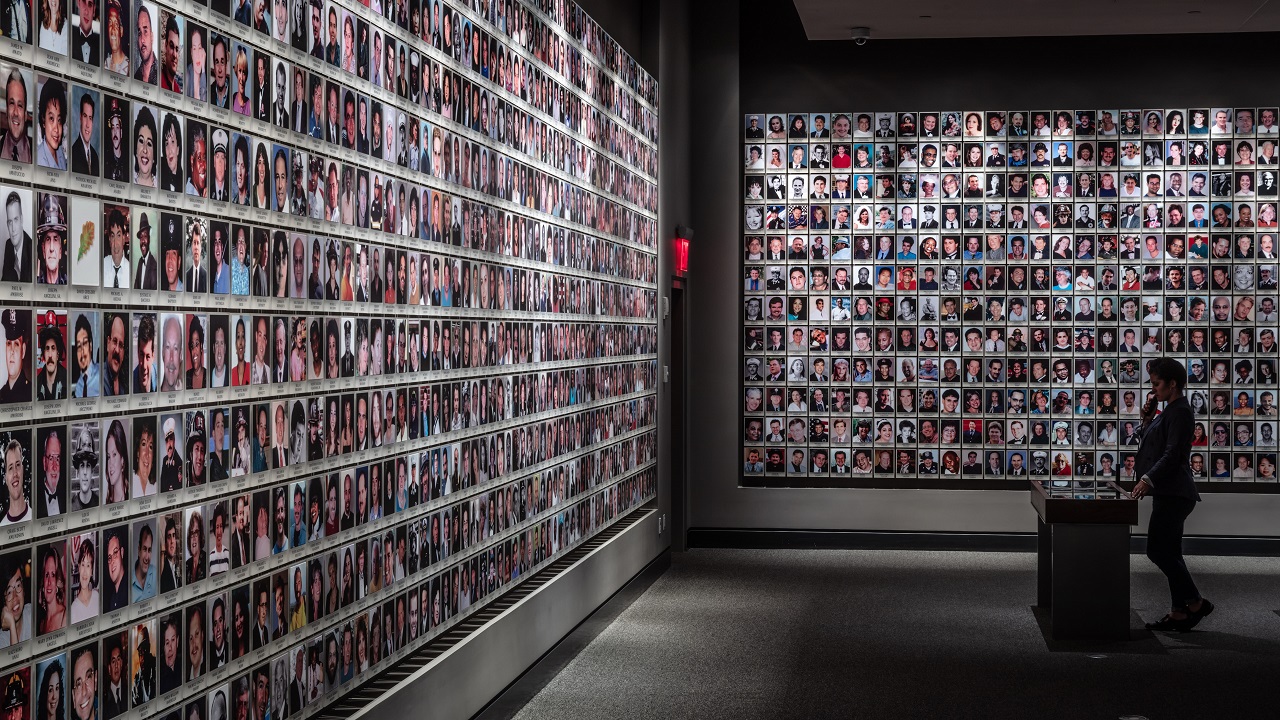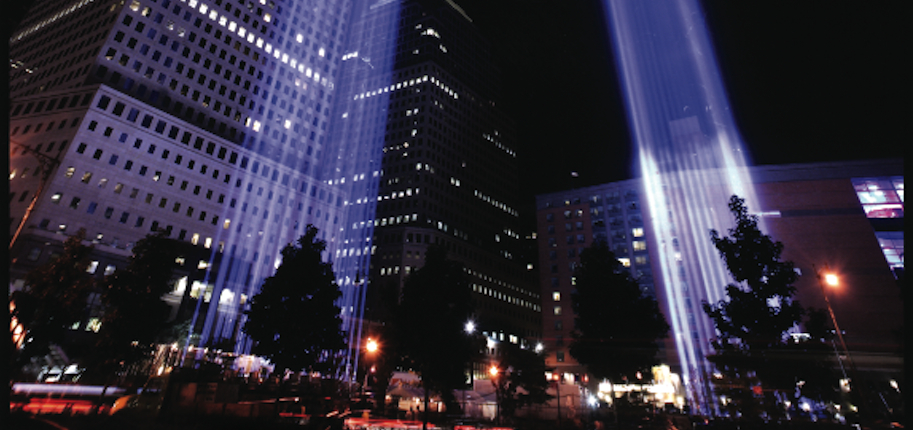The September 11th Families Association have taken over a former deli on 120 Liberty Street, right across from the World Trade Center site, and created The Tribute Center – a very personal memorial. Photos, keepsakes, mementos, and tributes sent in by victims’ families all help the outsider get a firsthand feel for the immense tragedy of the day.
On September 11, 2001, my nineteenth birthday, I woke up in my St. Mary’s College of California dorm room to the sound of the phone ringing at 6:45 a.m. Groggily, I picked up and listened to my mom’s voice telling me to turn on my television. My memories of the rest of that day are strewn with images of planes crashing into buildings over and over again. I attempted to go to class, on the way seeing a crowd of students in the hallway huddled under a screen showing the crashing planes. My classes were all canceled except for one, in which my teary-eyed teacher asked the class to discuss the tragedy for about twenty minutes.
My boyfriend of the time took me out that night for a birthday dinner. The restaurant was eerily quiet except for another crowd huddled under another TV with more crashing planes, along with some images of dusty streets and crowds of horrified running people in between. While I understood that the disaster was huge, it seemed surreal to me. I felt very distant from it, and the bombardment of the repetitive footage of the crashing planes only numbed me and made it even harder to grasp the true immensity and horror of what had happened.
Four years later, I moved to New York City. I became a part of the amazing ebb, flow, and harmony that is Manhattan, and came to learn that this is a city full of persevering and talented people. There is an energy here that motivates and moves people; New Yorkers never stop moving and they are strong. They support each other.
In my first explorations of New York, of course I went to visit Ground Zero. I gazed over the construction site and thought, “This is all?” “I wonder what it looked like before.” I searched the area in front of the gaping hole in the ground for something, anything that would connect me to the disaster that had happened there. I found nothing but a metal chain link fence. Once again, I felt distant, empty, and removed. There were a few other lost-looking people at the site and I could tell that they felt the same. Were we supposed to just forget about it and move on? It felt wrong.
Recently I have had the privilege of meeting with former New York City Fire Department Deputy Commissioner Lynn Tierney, who responded to the attacks of September 11, narrowly escaping injury in the collapse of Tower One. Lynn was one of the few women working in the mostly male FDNY, and was greatly endeared by them. She lost many of those firefighters on September 11th and since that day has continually worked to support others who also experienced loss. A valued leader of the September 11th Families Association, which unites and supports families of those who were lost, Lynn has a presence that is both comforting and strong. She is now the president of the Tribute Center.
Lynn assured me that I am not alone in the distance and disconnection that I felt as I stared over Ground Zero. In fact, the members of the September 11th Families Association used to look out the windows of their office to see thousands of baffled people mill around the site. Visitors do not come just to see the remains; they want the whole story. And while they have been searching for at least a piece of it, the survivors and family members of victims have been continually recovering. They carry their stories with them, and need to share them as a part of their healing. They too have been visiting the site to pay tribute to their loved ones, sadly finding very little recognition of their tragedy. The Families Association saw a solution. Visitors of the WTC site want to learn. The victims have the knowledge and need an outlet through which to share. It was a perfect match.
Chance had it that an empty deli was right across the street from the World Trade Center site and next door to Engine Company 10 and Ladder Company 10. Phone calls were made and the Association was able to secure the former Liberty Deli as its own. With a lot of planning, and the help of the Lower Manhattan Development Corporation and the Port Authority of New York and New Jersey who are funding the $3.3 million center, the former deli has become the Tribute Memorial Center; the fruitless searching is over.
During the planning and construction of the Tribute Center, the Families Association has been filling the “emptiness” with daily walking tours of the site. Led by family members who lost loved ones, rescue workers, and survivors of the attacks, the tour is an hour long, and consists of five stops around the World Trade Center site. The tours, like the memorial, give the public a chance to learn the story of September 11th from a voice of experience, and facilitate the healing process for the tour leaders.
Walking through Tribute did more than help me feel connected. It saddened, enraged, overwhelmed me, and made me feel proud. Most importantly though, it brought me to the heart of the situation through stories of personal experience and helped me to finally have a true sense of the magnitude of pain and loss created by the terrorist attacks.
Upon entering Tribute, Gallery 1 visitors are introduced to what the World Trade Center once was. The first object they see is an 8-foot model of the twin towers set in a grid on the floor of the surrounding area, lower Manhattan. The model faces a photographic wall mural of the view from the top of the towers. The mural is geographically correct, facing the water, and gives an idea of what it had been like to look out from the top of the towers. A video presents the liveliness of the World Trade Center community, which included concerts in the plaza and decorations every Christmastime, using actual footage of the World Trade Center as well as descriptions by people who were there.
Bridging the first gallery to the second is the first of a series of 13-foot high panels, which are the exact dimensions of the windows of the towers. The first panel tells the story of the first terrorist attack on February 26, 1993. The second gallery, a 40-foot-long corridor of panels, follows, each panel a piece of the timeline of the events of September 11, 2001. Unlike a typical museum presentation of history, this minute-by-minute breakdown of the day is presented as a series of firsthand experiences; we learn what it was like for specific people in specific parts of the day. Objects give life to those tragic moments, such as a pair of shoes that a woman wore as she ran down 92 flights of stairs, and a cell phone that a man grabbed on his way out of his office. Audio, video, quotes and photos are also used. Opposite the timeline is a wall mural that starts out bright blue, the color of the sky early on September 11. Gradually, missing posters appear in the blue, clouding and covering it and then completely obliterating the blue at the end of the wall.
The third gallery is dedicated to rescue and recovery operations. The first thing people notice in this gallery is a giant piece of steel from the World Trade Center that was twisted and mangled on 9/11. Huge graphics, objects, and film pay tribute to the many individuals and organizations that rushed to the site and worked tirelessly for months on the recovery effort.
One of these individuals is Lee Ielpi, the Tribute Center’s co-founder. Lee, a retired firefighter who had specialized in search and rescue, was a key player in the recovery operations.
Lee lost his son Jonathan, also a firefighter, on September 11. The gallery displays the mutilated fireman’s jacket that Jonathan was wearing when he was finally found in the wreckage of the South Tower on December 11, 2001.
The last gallery on the main level displays the names of the victims, as well as photos, keepsakes, mementos, and tributes sent in by victims’ families. One of the first items received was a photo of the beautiful Joanne Creegan sent from her family who misses her in Dublin, where she was born and raised. From posters made by children proclaiming how much they love and miss their mom or dad to a death certificate showing that the death was, by law, a homicide, this gallery allows victims’ families to participate, pay tribute, and show a piece of their experience to the world.

Photo: Dan Winters, courtesy of the 9/11 Tribute Museum.
The fifth and final gallery is on the lower level of the center. This gallery features images and objects that reflect the outpouring of support that came from across the nation and across the world. After the emotional journey that the center takes one through upstairs, this gallery is like a much-needed hug. Included are origami cranes of peace sent from Japan and a quote from a eulogy given by CEO Pat Ryan of AON that speaks of the way that disaster can put us in touch with our “aon,” which is Gaelic for oneness or unity. Said Ryan, “Suffering together reminds us of the truth of our humanity. It reminds us that none of us is truly alone. We are interconnected.” Group meetings and programs will be scheduled in this gallery.
Some may find the Tribute Center shocking and overwhelming. The stories are hard to listen to and the images hard to look at. The memorial evokes emotion that will remain with people long after they walk out the door. Is it too much? No. It is exactly what is needed to educate visitors and commemorate a tragedy of this size.
Tribute gives the public what the media failed to give us: human beings. While news reports allowed us to get only so close to the people and events of 9/11, the Tribute Center lets us zoom in. It is as if a friend is sitting there and opening up about a painful experience. And the survivors get to feel the benefits of that kind of sharing as well. Says Kate McPadden, who lost her husband, a firefighter, to 9/11, speaking about both leading the World Trade Center tours and the Tribute Center: “The best thing is the person-to-person connection.” Many tears will be shed inside the Tribute Center, but, in the wake of one of our nation’s greatest catastrophes, it feels right to finally have real names and faces to grieve for. ♦
Michelle Harty’s article originally appeared in the October 2006 issue of Irish America. In 2017 the 9/11 Tribute Museum relocated to 92 Greenwich St. NY, NY 10006. To learn more visit 9/11 Tribute Museum.


Leave a Reply